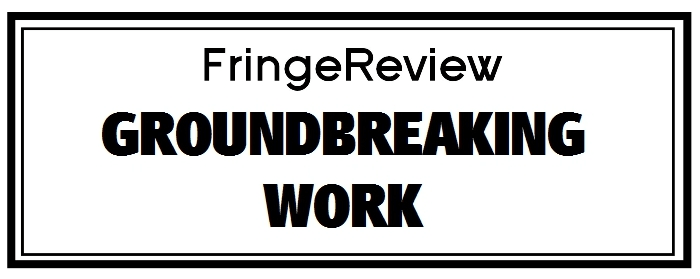FringeReview UK 2018
Hole
Royal Court Theatre and Jwerwood New Playwrights Programme

Genre: Contemporary, Dance and Movement Theatre, Experimental, Immersive, Live Music, Musical Theatre, New Writing, Short Plays, Theatre
Venue: Royal Court Jerwood Theatre Upstairs
Festival: FringeReview UK
Low Down
Directed by Helen Goalen and Abbi Greenland of RashDash theatre company Cécile Trémolieres’ design is a black but star-spangled coffin-shaped thrust stage. Saturation lighting by Katharine Williams is a character in itself. Then there’s Ebony Bones’ score, much of which she performs as part of the ensemble, working with Emily Legg’s punchy sound. Ruth Best’s explosive neon and diaphanous costumes taunt and celebrate. Till January 12th.
Review
Ever seen a singularity? As an astro-physical answer to deadly theatre this takes some beating and given the content, that’s a phrase worth using advisedly.
As an actor Ellie Kendrick’s attuned to theatricality, not static wordiness. So after several trial pieces, her debut’s drenched in process. Directed by Helen Goalen and Abbi Greenland of the feminist theatre company RashDash it starts with a literal whimper ‘I need you to listen’ with several sorrys. In the resulting explosion it never apologizes again. By the time we return to those very words, we’ve been gloriously stupefied.
Written in the summer of 2016, before #metoo, Hole nevertheless plunges just into that territory in the brilliant prologue, where a woman slides down a pole in a spotlight and tries to explain something violating, with the use of a mic.
She’s stopped by the mic switching off, the spotlight moving off, a hole opening up. It happens again and again, more rapidly to her and subsequent speakers. Even a confidant stand-up is reduced to slithering around after a spotlight that allows a voice and with a sonic whoosh denies it. The last woman of the six-strong ensemble lies down. She then vanishes down the trap door like the rest.
Cécile Trémolieres’ design is a black but star-spangled coffin-shaped thrust stage with the auditorium similarly spaced out. There’s a large access hole where women clamber out around what looks like pink candy floss, and one cradled above the stage inhabiting a space where a town clock might have been. In green neon robes.
This show does address black holes after all. And a swing. Ruth Best’s explosive neon and diaphanous costumes taunt and celebrate, gather up regally and turn their wearers vulnerable.
Above all the saturation lighting by Katharine Williams – perhaps the finest I’ve seen at the Court Upstairs – is a character in itself. Not just the menacing spotlight, but the nimbus effects, strobes and an active light-show repertoire throughout the sixty-five minutes’ duration.
Then there’s Ebony Bones’ score, much of which she performs as part of the ensemble, working with Emily Legg’s punchy sound, not too overwhelming in such a space.
The depth and scale of this belies that space, but most outsize – and Kendrick defines ‘big’ at the outset – are the six performers. One, Cassie Layton, plays a thrillingly wild sax. Another goes bare-chested as the Bacchantes take hold of the narrative. Ronke Adekoluejo, Bones herself, Alison Halstead, Rubyy Jones, Eva Magyar, take centre then dissolve back. All make an individual impression, all sustain high energy with lyricism and mischief.
After the tight opening which suggests almost a different show, we’re ushered to the way the Furies – sometime Bacchantes – orate parts of Kendrick’s spiralling monologue. Kendrick states it isn’t a poem, though its freewheeling DNA twist of text often formalises itself as that, a flexible threshing thing sometimes diffused into a cloud of block concrete verse, more often iterated with each speaker taking a numbered line as it’s tossed back and forth.
There is a freely segmented narrative, partly fastening on how various women like Pandora and Medusa are traduced into their mythic roles. In the latter’s case it’s Medusa’s getting turned into a head-snake-writhe by a goddess furious at her blonde hair and beauty in her temple; of course Medusa’s lopped off by Perseus with a mirror, for having turned everyone into stone.
So it’s not invariably men, but is patriarchy. ‘Do not, under any circumstances, interrupt our grinding!’ they warn and who would as the ensemble parody burlesque? One routine has women miming wrestling, another male voyeuristic sport. Hole taunts as it celebrates.
There’s a touch of Clare Barron’s Dance Nation in Hole’s raucous stomping affirmation and it’s exciting to see this was developed in parallel, suggesting a spontaneous generation before the #metoo moment, itself part of the same instant.
Hole though goes beyond, not only in singularity metaphor but in its scope, a desire to ‘swallow’ and ’digest’ all experience. Images of chewing and violence punctuate the text. More than anything this comes over as a live show, Bones’ music and Williams’ lighting almost suffusing words in a halo of chant.
Though quiet passages haunt, the more strident can fuzz at the edges; only a quick glance at text in strobe lighting clarifies. The greatest drawback is that words can be subordinated for several minutes at a time, and with the magnificently relentless ride these yammerings tire out the language before they exhaust its possibilities.
In Hole Kendrick creates a raw-lipped show that can devour and we need another work from her soon, if only to attune to her sheer difference. Inchoate moments here are readily forgiven for the sheer energy they occasion and drive through. There’s a sense in which this piece generates a single arc of high intensity and not conflictual drama. It’s wow drama, the original Greek tragoidia, though. It invokes the same powers, almost the same gods.


















































